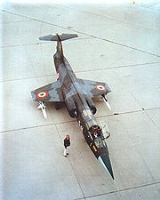
Aeritalia F-104S
Encyclopedia
The Aeritalia F-104S Starfighter was a licensed production Italian
version of the Lockheed
F-104 Starfighter
which served in the Italian Air Force (AMI, Aeronautica Militare Italiana), and was the AMI's mainstay from the late 1960s until the beginning of the 21st Century. The F-104S also served in the Turkish Air Force
until the mid-1990s. The F-104S was the final development of the Starfighter line.
Derived from Lockheed's design studies on a "Super Starfighter", the F-104S was one of the most capable of the F-104 series, and destined to be the last in service worldwide. The F-104S (upgraded to ASA/M standard) was retired from service in October 2004.
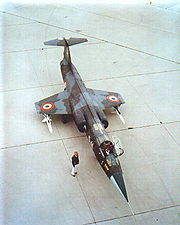 The F-104 series had entered a second development phase with the F-104G. While the USAF had no more interest in the F-104, Lockheed
The F-104 series had entered a second development phase with the F-104G. While the USAF had no more interest in the F-104, Lockheed
proposed the Model CL-901 featuring the new J79-GE-19 engine and the Sparrow III missiles; "G" denoted "Germany", the lead country for this version, while "S" indicated the improved "Sparrow" version. Further proposed developments included the CL-958 with larger wings, the CL-981 with retractable canard
wings behind the cockpit, and the CL-984 optimised for low-level strike missions. An RF-104G was modified and flew in December 1966 as the prototype CL-901 "Super Starfighter". Externally, the new type had slightly larger air intakes and steel inlet guide vanes that allowed an increase in operating temperature
from 121°C to 175°C, enabling a maximum speed of Mach 2.2.
During the first five years in Italian service, 23 F-104G aircraft were lost; and as only 80 to 90 F-104s (of 149 acquired) were operational at best, it was decided to purchase a new interceptor and fighter-bomber to reinforce the first line units.
The AMI mid-1960s "AW-X" (All-Weather-X aircraft) requirement for a new all-weather fighter aircraft led to an evaluation of many available types: the McDonnell Douglas F-4B/C Phantom
, Mirage IIIC-1
, BAC
Lightning
and North American F-100S Super Sabre
among others. The eventual choice was the Lockheed CL-980 (a simplified version with the same wings of the projected Model CL-901). On 26 January 1966, the AMI chose the definitive F-104S as their future fighter. The first F-104S was actually a modified Fiat
-built F-104G, MM6658, that acted as an aerodynamic prototype and first flew on 22 December 1966, while a second prototype, MM6660, fitted with new avionics systems closer to the final configuration, flew on 28 February 1967. MM.6701, the first production F-104S built by Aeritalia
flew on 30 December 1968.
The F-104S was designed to carry AIM-7 Sparrow
missiles (while deleting the Vulcan gun). In the attack role, the F-104S had nine hardpoints, and could carry up to seven 227 kg (500 lb) or 340 kg (750 lb) bombs; an improvement over the F-104G which could hold only half that payload on five hardpoints, two of which were needed for auxiliary tanks. Theoretically an F-104S could be equipped with four or five bombs, two tanks and two AIM-9s, becoming a dual-role aircraft.
The new type entered service in mid 1969, with 22° Gruppo (51° Stormo); and in that year, the F-104S accumulated 460 flying hours.
The AMI bought 205 examples, all delivered from 1969 to 1979, with the 100th aircraft delivered in January 1973, and the 200th in May 1976. The model was built in two versions; as an interceptor armed with AIM-7 Sparrow
missiles (the M61 Vulcan
being removed); and as a fighter bomber, with the gun retained and bombs and other air-to-surface ordnance. The models were interchangeable, making it unclear how many were built or rebuilt to these specifications.
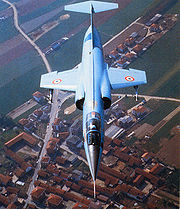 The J79-GE-19 allowed a faster climb, comparable with contemporary fighters (up to 277 m (909 ft)/sec, with a time-to-climb 10600 m (34,777 ft) of 80 seconds claimed; ten seconds less than the F-104G), with the capability of reaching Mach
The J79-GE-19 allowed a faster climb, comparable with contemporary fighters (up to 277 m (909 ft)/sec, with a time-to-climb 10600 m (34,777 ft) of 80 seconds claimed; ten seconds less than the F-104G), with the capability of reaching Mach
2 at 12000 m (39,370.1 ft) in around five minutes.
Napoleone Bragagnolo, a test pilot for Aeritalia, was able to land at Ciampino, Rome
, 19 minutes and 30 seconds after taking off from Turin
. During this flight with two wingtip auxiliary tanks, he climbed 15 km (49,213 ft) and accelerated to Mach 2. The aircraft still had 1300 l (2,747.4 US pt) of fuel onboard when it landed; enough to reach Palermo
at subsonic speeds. The average speed for the flight was Mach 1.5.
Even with these new Starfighters, the loss rate remained high, with peaks in 1973 and 1975 (ten F-104s of all versions were lost in AMI service during this period). Up to 1997, Italy had lost 137 (38%) of its F-104s in 928,000 flying hours (14.7 aircraft every 100,000 hours). Despite a drop in the loss rate in the 1980s (with 33 losses between 1981 and 1990 included), the debate about the reliability of this aircraft was often fierce in the mass media
. In the 1980s the loss rate dropped, even more so in the 1990s, when all the old versions (except TF-104s) were scrapped.
The last Italian F-104 was decommissioned in 2004, after the type had flown around a million flying hours in a total of over 40 years of service.
was the only other customer for the Aeritalia F-104S. The initial order was placed in 1974, with the first of 18 examples entering service by December 1974. These first aircraft were a gift from Libya
; the reward for Turkish technical assistance to improve the capabilities of the Libyan Air Force
. Another 18 were ordered in May 1975, which eventually increased to 40 aircraft, but another batch (for 20 aircraft) was dropped, probably because F-4's were delivered as well. They served with 142 and 182 Filo from the 1970s, and around a dozen were still in service until the mid-1990s. While 200 Selenia AIM-7 missiles were delivered, Turkish F-104Ss were seldom seen carrying them, thus F-4E's were probably the main users of those missiles.
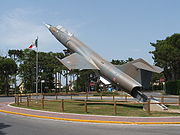 Two further update programs were carried out prior to the introduction into AMI service of the Eurofighter Typhoon
Two further update programs were carried out prior to the introduction into AMI service of the Eurofighter Typhoon
, resulting in the F-104S-ASA and F-104S-ASA/M.
missile. AIM-9Ls were then used as the main armament, replacing the previous "B" and "F" version of this missile, while the older AIM-7s were retained. One AIM-7 was usually carried under each wing. In total, 147 of the F-104S airframes were converted to ASA standard at an expense of around 600 billion lire
, the last ASA model was delivered in the early 1990s.
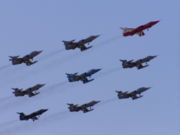 F-104S (Lockheed Model CL-901): 246 aircraft produced mainly by Fiat
F-104S (Lockheed Model CL-901): 246 aircraft produced mainly by Fiat
and Aeritalia
(one aircraft was lost before delivery), upgraded for the interception role having NASARR R-21G/H radar with moving target indicator and continuous wave illuminator for SARH
missiles (initially AIM-7 Sparrow
), two additional wing and two underbelly hardpoints (to give a total of nine), uprated J79-GE-19 engine with 52.8 kN (11,870 lbf) thrust (79.6 kN/17,900 lbf with afterburner), and two additional ventral fins for increased stability at high Mach numbers. The 20 mm (.79 in) M61 cannon was sacrificed to make room for the missile avionics, the cannon was always fitted to fighter-bomber variants. Up to two Sparrow; and two, theoretically four or six, Sidewinder missiles were carried on all the hardpoints except the central (underbelly), or seven 340 kg (750 lb) bombs (normally, two-four 227–340 kg/500-750 lb). Range was up to 1,250 km (777 mi) with four tanks, ferry range 2,940 km (1,827 mi).
F-104S-ASA: (Aggiornamento Sistemi d'Arma - "Weapon Systems Update") - An upgraded Italian version, with 147 modified from existing airframes, upgraded with Fiat R21G/M1 radar with frequency hopping, look-down/shoot-down capability, new IFF
and weapons delivery computer, and provision for AIM-9L all-aspect Sidewinder and Selenia Aspide
missiles. Due to the delays of Aspide integration, it was also called the ASA-1 with Sparrows, and ASA-2 when the Aspide became available, and eventually all F-104Ss were upgraded to ASA-2 standard. The fighter-bombers had no substantial improvements in the "ASA" version, and were later modified to interceptor standards (CI) without the M61.
F-104S-ASA/M: (Aggiornamento Sistemi d'Arma/Modificato - "Weapon Systems Update/Modified") - 49 F-104S-ASA and 15 two-seat TF-104G aircraft were upgraded from 1998 to ASA/M standard with GPS
, new TACAN
and Litton LN-30A2 INS
, refurbished airframe, and improved cockpit displays. All strike-related equipment was removed, and the IRST as well (the small unit known as 'IR-Sight', forward the windshield). The last Starfighters in combat service, they were withdrawn in October 2004 (the last unit was 10° Gruppo/9° Stormo, Grazzanise
), and temporarily replaced by the F-16 Fighting Falcon
, while awaiting Eurofighter Typhoon
deliveries.

Italy
Italy , officially the Italian Republic languages]] under the European Charter for Regional or Minority Languages. In each of these, Italy's official name is as follows:;;;;;;;;), is a unitary parliamentary republic in South-Central Europe. To the north it borders France, Switzerland, Austria and...
version of the Lockheed
Lockheed Corporation
The Lockheed Corporation was an American aerospace company. Lockheed was founded in 1912 and later merged with Martin Marietta to form Lockheed Martin in 1995.-Origins:...
F-104 Starfighter
F-104 Starfighter
The Lockheed F-104 Starfighter is a single-engine, high-performance, supersonic interceptor aircraft originally developed for the United States Air Force by Lockheed. One of the Century Series of aircraft, it served with the USAF from 1958 until 1969, and continued with Air National Guard units...
which served in the Italian Air Force (AMI, Aeronautica Militare Italiana), and was the AMI's mainstay from the late 1960s until the beginning of the 21st Century. The F-104S also served in the Turkish Air Force
Turkish Air Force
The Turkish Air Force is the aerial warfare service branch of the Turkish Armed Forces. It ranks 3rd in NATO in terms of fleet size behind the USAF and Royal Air Force with a current inventory of 798 aircraft .-Initial stages:...
until the mid-1990s. The F-104S was the final development of the Starfighter line.
Derived from Lockheed's design studies on a "Super Starfighter", the F-104S was one of the most capable of the F-104 series, and destined to be the last in service worldwide. The F-104S (upgraded to ASA/M standard) was retired from service in October 2004.
Design and development

Lockheed Corporation
The Lockheed Corporation was an American aerospace company. Lockheed was founded in 1912 and later merged with Martin Marietta to form Lockheed Martin in 1995.-Origins:...
proposed the Model CL-901 featuring the new J79-GE-19 engine and the Sparrow III missiles; "G" denoted "Germany", the lead country for this version, while "S" indicated the improved "Sparrow" version. Further proposed developments included the CL-958 with larger wings, the CL-981 with retractable canard
Canard (aeronautics)
In aeronautics, canard is an airframe configuration of fixed-wing aircraft in which the forward surface is smaller than the rearward, the former being known as the "canard", while the latter is the main wing...
wings behind the cockpit, and the CL-984 optimised for low-level strike missions. An RF-104G was modified and flew in December 1966 as the prototype CL-901 "Super Starfighter". Externally, the new type had slightly larger air intakes and steel inlet guide vanes that allowed an increase in operating temperature
Operating temperature
An operating temperature is the temperature at which an electrical or mechanical device operates. The device will operate effectively within a specified temperature range which varies based on the device function and application context, and ranges from the minimum operating temperature to the...
from 121°C to 175°C, enabling a maximum speed of Mach 2.2.
During the first five years in Italian service, 23 F-104G aircraft were lost; and as only 80 to 90 F-104s (of 149 acquired) were operational at best, it was decided to purchase a new interceptor and fighter-bomber to reinforce the first line units.
The AMI mid-1960s "AW-X" (All-Weather-X aircraft) requirement for a new all-weather fighter aircraft led to an evaluation of many available types: the McDonnell Douglas F-4B/C Phantom
F-4 Phantom II
The McDonnell Douglas F-4 Phantom II is a tandem two-seat, twin-engined, all-weather, long-range supersonic jet interceptor fighter/fighter-bomber originally developed for the United States Navy by McDonnell Aircraft. It first entered service in 1960 with the U.S. Navy. Proving highly adaptable,...
, Mirage IIIC-1
Dassault Mirage III
The Mirage III is a supersonic fighter aircraft designed by Dassault Aviation during the late 1950s, and manufactured both in France and a number of other countries. It was a successful fighter aircraft, being sold to many air forces around the world and remaining in production for over a decade...
, BAC
British Aircraft Corporation
The British Aircraft Corporation was a British aircraft manufacturer formed from the government-pressured merger of English Electric Aviation Ltd., Vickers-Armstrongs , the Bristol Aeroplane Company and Hunting Aircraft in 1960. Bristol, English Electric and Vickers became "parents" of BAC with...
Lightning
English Electric Lightning
The English Electric Lightning is a supersonic jet fighter aircraft of the Cold War era, noted for its great speed and unpainted natural metal exterior finish. It is the only all-British Mach 2 fighter aircraft. The aircraft was renowned for its capabilities as an interceptor; Royal Air Force ...
and North American F-100S Super Sabre
F-100 Super Sabre
The North American F-100 Super Sabre was a supersonic jet fighter aircraft that served with the United States Air Force from 1954 to 1971 and with the Air National Guard until 1979. The first of the Century Series collection of USAF jet fighters, it was the first USAF fighter capable of...
among others. The eventual choice was the Lockheed CL-980 (a simplified version with the same wings of the projected Model CL-901). On 26 January 1966, the AMI chose the definitive F-104S as their future fighter. The first F-104S was actually a modified Fiat
Fiat
FIAT, an acronym for Fabbrica Italiana Automobili Torino , is an Italian automobile manufacturer, engine manufacturer, financial, and industrial group based in Turin in the Italian region of Piedmont. Fiat was founded in 1899 by a group of investors including Giovanni Agnelli...
-built F-104G, MM6658, that acted as an aerodynamic prototype and first flew on 22 December 1966, while a second prototype, MM6660, fitted with new avionics systems closer to the final configuration, flew on 28 February 1967. MM.6701, the first production F-104S built by Aeritalia
Aeritalia
Aeritalia was an aerospace engineering corporation based in Italy, originally Fiat Aviazione before merging with Aerfer, and now part of Alenia Aeronautica....
flew on 30 December 1968.
The F-104S was designed to carry AIM-7 Sparrow
AIM-7 Sparrow
The AIM-7 Sparrow is an American, medium-range semi-active radar homing air-to-air missile operated by the United States Air Force, United States Navy and United States Marine Corps, as well as various allied air forces and navies. Sparrow and its derivatives were the West's principal beyond visual...
missiles (while deleting the Vulcan gun). In the attack role, the F-104S had nine hardpoints, and could carry up to seven 227 kg (500 lb) or 340 kg (750 lb) bombs; an improvement over the F-104G which could hold only half that payload on five hardpoints, two of which were needed for auxiliary tanks. Theoretically an F-104S could be equipped with four or five bombs, two tanks and two AIM-9s, becoming a dual-role aircraft.
The new type entered service in mid 1969, with 22° Gruppo (51° Stormo); and in that year, the F-104S accumulated 460 flying hours.
The AMI bought 205 examples, all delivered from 1969 to 1979, with the 100th aircraft delivered in January 1973, and the 200th in May 1976. The model was built in two versions; as an interceptor armed with AIM-7 Sparrow
AIM-7 Sparrow
The AIM-7 Sparrow is an American, medium-range semi-active radar homing air-to-air missile operated by the United States Air Force, United States Navy and United States Marine Corps, as well as various allied air forces and navies. Sparrow and its derivatives were the West's principal beyond visual...
missiles (the M61 Vulcan
M61 Vulcan
The M61 Vulcan is a hydraulically or pneumatically driven, six-barreled, air-cooled, electrically fired Gatling-style rotary cannon which fires 20 mm rounds at an extremely high rate. The M61 and its derivatives have been the principal cannon armament of United States military fixed-wing aircraft...
being removed); and as a fighter bomber, with the gun retained and bombs and other air-to-surface ordnance. The models were interchangeable, making it unclear how many were built or rebuilt to these specifications.
Italian service
AMI squadrons equipped with the F-104G and S versions were: 9, 10, 12, 18 (dual), 20 (training), 21, 22, 23, 28, 102 (reconnaissance), 154, 155, and 156 (bombers).
Mach number
Mach number is the speed of an object moving through air, or any other fluid substance, divided by the speed of sound as it is in that substance for its particular physical conditions, including those of temperature and pressure...
2 at 12000 m (39,370.1 ft) in around five minutes.
Napoleone Bragagnolo, a test pilot for Aeritalia, was able to land at Ciampino, Rome
Rome
Rome is the capital of Italy and the country's largest and most populated city and comune, with over 2.7 million residents in . The city is located in the central-western portion of the Italian Peninsula, on the Tiber River within the Lazio region of Italy.Rome's history spans two and a half...
, 19 minutes and 30 seconds after taking off from Turin
Turin
Turin is a city and major business and cultural centre in northern Italy, capital of the Piedmont region, located mainly on the left bank of the Po River and surrounded by the Alpine arch. The population of the city proper is 909,193 while the population of the urban area is estimated by Eurostat...
. During this flight with two wingtip auxiliary tanks, he climbed 15 km (49,213 ft) and accelerated to Mach 2. The aircraft still had 1300 l (2,747.4 US pt) of fuel onboard when it landed; enough to reach Palermo
Palermo
Palermo is a city in Southern Italy, the capital of both the autonomous region of Sicily and the Province of Palermo. The city is noted for its history, culture, architecture and gastronomy, playing an important role throughout much of its existence; it is over 2,700 years old...
at subsonic speeds. The average speed for the flight was Mach 1.5.
Even with these new Starfighters, the loss rate remained high, with peaks in 1973 and 1975 (ten F-104s of all versions were lost in AMI service during this period). Up to 1997, Italy had lost 137 (38%) of its F-104s in 928,000 flying hours (14.7 aircraft every 100,000 hours). Despite a drop in the loss rate in the 1980s (with 33 losses between 1981 and 1990 included), the debate about the reliability of this aircraft was often fierce in the mass media
Mass media
Mass media refers collectively to all media technologies which are intended to reach a large audience via mass communication. Broadcast media transmit their information electronically and comprise of television, film and radio, movies, CDs, DVDs and some other gadgets like cameras or video consoles...
. In the 1980s the loss rate dropped, even more so in the 1990s, when all the old versions (except TF-104s) were scrapped.
The last Italian F-104 was decommissioned in 2004, after the type had flown around a million flying hours in a total of over 40 years of service.
Turkish service
TurkeyTurkey
Turkey , known officially as the Republic of Turkey , is a Eurasian country located in Western Asia and in East Thrace in Southeastern Europe...
was the only other customer for the Aeritalia F-104S. The initial order was placed in 1974, with the first of 18 examples entering service by December 1974. These first aircraft were a gift from Libya
Libya
Libya is an African country in the Maghreb region of North Africa bordered by the Mediterranean Sea to the north, Egypt to the east, Sudan to the southeast, Chad and Niger to the south, and Algeria and Tunisia to the west....
; the reward for Turkish technical assistance to improve the capabilities of the Libyan Air Force
Libyan Air Force
The Libyan Air Force is the branch of the Libyan Armed Forces responsible for aerial warfare. In 2010, before the 2011 Libyan civil war, the Libyan Air Force personnel strength was estimated at 18,000, with an inventory of 374 combat capable aircraft operating from 13 military airbases in...
. Another 18 were ordered in May 1975, which eventually increased to 40 aircraft, but another batch (for 20 aircraft) was dropped, probably because F-4's were delivered as well. They served with 142 and 182 Filo from the 1970s, and around a dozen were still in service until the mid-1990s. While 200 Selenia AIM-7 missiles were delivered, Turkish F-104Ss were seldom seen carrying them, thus F-4E's were probably the main users of those missiles.
Mid-life updates

Eurofighter Typhoon
The Eurofighter Typhoon is a twin-engine, canard-delta wing, multirole combat aircraft, designed and built by a consortium of three companies: EADS, Alenia Aeronautica and BAE Systems; working through a holding company, Eurofighter GmbH, which was formed in 1986...
, resulting in the F-104S-ASA and F-104S-ASA/M.
F-104S-ASA
The F-104ASA (Aggiornamento Sistemi d'Arma), developed in 1986, introduced a Fiar Setter radar, with 'look-down' capability and compatibility with the Selenia AspideSelenia Aspide
The Aspide is an Italian medium range air-to-air and surface-to-air missile produced by Selenia . It is provided with semi-active radar-homing seeker...
missile. AIM-9Ls were then used as the main armament, replacing the previous "B" and "F" version of this missile, while the older AIM-7s were retained. One AIM-7 was usually carried under each wing. In total, 147 of the F-104S airframes were converted to ASA standard at an expense of around 600 billion lire
Italian lira
The lira was the currency of Italy between 1861 and 2002. Between 1999 and 2002, the Italian lira was officially a “national subunit” of the euro...
, the last ASA model was delivered in the early 1990s.
F-104S-ASA/M
The ASA/M upgrade (initially known as the 'ECO' (Estensione Capacità Operative) upgrade) focused on improving reliability rather than combat enhancements, and involved 49 ASA aircraft. 15 TF-104Gs were also involved in this program .Variants

Fiat
FIAT, an acronym for Fabbrica Italiana Automobili Torino , is an Italian automobile manufacturer, engine manufacturer, financial, and industrial group based in Turin in the Italian region of Piedmont. Fiat was founded in 1899 by a group of investors including Giovanni Agnelli...
and Aeritalia
Aeritalia
Aeritalia was an aerospace engineering corporation based in Italy, originally Fiat Aviazione before merging with Aerfer, and now part of Alenia Aeronautica....
(one aircraft was lost before delivery), upgraded for the interception role having NASARR R-21G/H radar with moving target indicator and continuous wave illuminator for SARH
Semi-active radar homing
Semi-active radar homing, or SARH, is a common type of missile guidance system, perhaps the most common type for longer-range air-to-air and surface-to-air missile systems. The name refers to the fact that the missile itself is only a passive detector of a radar signal – provided by an external ...
missiles (initially AIM-7 Sparrow
AIM-7 Sparrow
The AIM-7 Sparrow is an American, medium-range semi-active radar homing air-to-air missile operated by the United States Air Force, United States Navy and United States Marine Corps, as well as various allied air forces and navies. Sparrow and its derivatives were the West's principal beyond visual...
), two additional wing and two underbelly hardpoints (to give a total of nine), uprated J79-GE-19 engine with 52.8 kN (11,870 lbf) thrust (79.6 kN/17,900 lbf with afterburner), and two additional ventral fins for increased stability at high Mach numbers. The 20 mm (.79 in) M61 cannon was sacrificed to make room for the missile avionics, the cannon was always fitted to fighter-bomber variants. Up to two Sparrow; and two, theoretically four or six, Sidewinder missiles were carried on all the hardpoints except the central (underbelly), or seven 340 kg (750 lb) bombs (normally, two-four 227–340 kg/500-750 lb). Range was up to 1,250 km (777 mi) with four tanks, ferry range 2,940 km (1,827 mi).
F-104S-ASA: (Aggiornamento Sistemi d'Arma - "Weapon Systems Update") - An upgraded Italian version, with 147 modified from existing airframes, upgraded with Fiat R21G/M1 radar with frequency hopping, look-down/shoot-down capability, new IFF
Identification friend or foe
In telecommunications, identification, friend or foe is an identification system designed for command and control. It is a system that enables military and national interrogation systems to identify aircraft, vehicles, or forces as friendly and to determine their bearing and range from the...
and weapons delivery computer, and provision for AIM-9L all-aspect Sidewinder and Selenia Aspide
Selenia Aspide
The Aspide is an Italian medium range air-to-air and surface-to-air missile produced by Selenia . It is provided with semi-active radar-homing seeker...
missiles. Due to the delays of Aspide integration, it was also called the ASA-1 with Sparrows, and ASA-2 when the Aspide became available, and eventually all F-104Ss were upgraded to ASA-2 standard. The fighter-bombers had no substantial improvements in the "ASA" version, and were later modified to interceptor standards (CI) without the M61.
F-104S-ASA/M: (Aggiornamento Sistemi d'Arma/Modificato - "Weapon Systems Update/Modified") - 49 F-104S-ASA and 15 two-seat TF-104G aircraft were upgraded from 1998 to ASA/M standard with GPS
Global Positioning System
The Global Positioning System is a space-based global navigation satellite system that provides location and time information in all weather, anywhere on or near the Earth, where there is an unobstructed line of sight to four or more GPS satellites...
, new TACAN
Tactical Air Navigation
A tactical air navigation system, commonly referred to by the acronym TACAN, is a navigation system used by military aircraft. It provides the user with bearing and distance to a ground or ship-borne station. It is a more accurate version of the VOR/DME system that provides bearing and range...
and Litton LN-30A2 INS
Inertial navigation system
An inertial navigation system is a navigation aid that uses a computer, motion sensors and rotation sensors to continuously calculate via dead reckoning the position, orientation, and velocity of a moving object without the need for external references...
, refurbished airframe, and improved cockpit displays. All strike-related equipment was removed, and the IRST as well (the small unit known as 'IR-Sight', forward the windshield). The last Starfighters in combat service, they were withdrawn in October 2004 (the last unit was 10° Gruppo/9° Stormo, Grazzanise
Grazzanise
Grazzanise is a comune in the Province of Caserta in the Italian region Campania, located about 30 km northwest of Naples and about 20 km west of Caserta.-History:...
), and temporarily replaced by the F-16 Fighting Falcon
F-16 Fighting Falcon
The General Dynamics F-16 Fighting Falcon is a multirole jet fighter aircraft originally developed by General Dynamics for the United States Air Force . Designed as an air superiority day fighter, it evolved into a successful all-weather multirole aircraft. Over 4,400 aircraft have been built since...
, while awaiting Eurofighter Typhoon
Eurofighter Typhoon
The Eurofighter Typhoon is a twin-engine, canard-delta wing, multirole combat aircraft, designed and built by a consortium of three companies: EADS, Alenia Aeronautica and BAE Systems; working through a holding company, Eurofighter GmbH, which was formed in 1986...
deliveries.
Operators
- Italian Air ForceItalian Air ForceThe Italian Air Force has gone under different names in different periods:*Regia Aeronautica , from 1923 to June 1946*Aeronautica Nazionale Repubblicana, the air force of Italian Social Republic during World War II...
- Turkish Air ForceTurkish Air ForceThe Turkish Air Force is the aerial warfare service branch of the Turkish Armed Forces. It ranks 3rd in NATO in terms of fleet size behind the USAF and Royal Air Force with a current inventory of 798 aircraft .-Initial stages:...
Specifications (F-104S)


